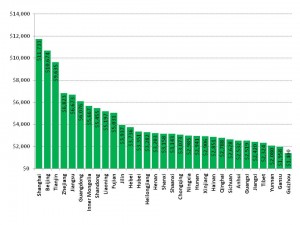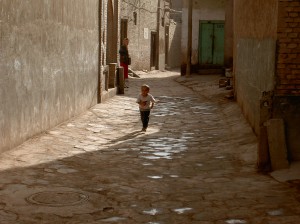The Coast with the Most: Income Inequality (收入不平等) Posted by Stephen on Apr 13, 2011 in News
Much like inflation, housing speculation and unemployment, income inequality is becoming a hot topic issue in China, stoking nationalist sentiment and prompting social movements and protests. For a supposed communist nation (although we know better), such a divide in wealth foments anger and fosters reactionary sentiment. As income inequality grows, so does the 800 pound gorilla in the room. China can keep it caged, but for how long?
Income inequality or 收入不平等 (shōu rù bù píng déng) can be statistically measured by the Gini coefficient, or the statistical dispersion/discrepancy among income classes. China’s Gini Coefficient is 41.5 and climbing quickly. The US is already at a staggering 45, placing it among the top 1/3 of mostly failed states where money equates into military might and political influence. See the CIA factbook for an entire list. In countries like the U.S. and China, these large margins between the rich and poor (or even the rich and middle class) greatly influence quality of life and standards of living.
In China, financial crunch, similar to what the US, EU and most of the world experienced during the last 3 years, is coming. Anecdotal stories of such are everywhere. Whether it’s a landlord being squeezed on by a corrupt official, a family that forces a breakup of an engagement due to poor “social status” or a factory worker whose family was so indebted that they couldn’t pay for the funeral, China is a polarized nation, filled with rich entrepreneurs and the remaining struggling masses. Now add in a housing bubble that is causing inflation and homelessness, and you have an idea just how hard it is to make it in China.
This fact is only amplified when you look at a break down of per capita GDP among provinces within China. Coastal provinces such as Zhejiang, Guangdong, Shanghai, Beijing, Shandong and Jiangsu all have staggeringly high GDP’s per capita and much higher average incomes than their inland counterparts. In fact, as you go west, there is a steady decline in average incomes, with periphery provinces like Tibet, Inner Mongolia and Xinjiang earning near half of their coastal-counterparts. As a result, development has faltered due to a lack of highways, railways, local governmental corruption and cultural discrimination in these innermost areas of China.
It’s not a surprise to me that most social conflict (be it ethnic minority riots, protests for housing relocation and demolition, or school attacks) happens in these very locations, where competition is everything and social mobility is a pipe-dream. We read about China’s amazing GDP, but seem to cast a blind eye to the other part of the country that is struggling to keep up. Uneven development leads to social despair, and ultimately, social unrest.

Build vocabulary, practice pronunciation, and more with Transparent Language Online. Available anytime, anywhere, on any device.
About the Author: Stephen
Writer and blogger for all things China related. Follow me on twitter: @seeitbelieveit -- My Background: Fluent Mandarin speaker with 3+ years working, living, studying and teaching throughout the mainland. Student of Kung Fu and avid photographer and documentarian.








Comments:
Peter Simon:
A very, very intelligent way of looking at the problems. Let me add that there’s no country on Earth without such differences, excepting perhaps the smallest ones with some special resources.